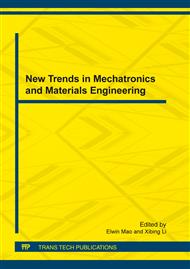[1]
B. L. Liu, B. T. Zhang, S. S. Cao, et al. Preparation of the stable core-shell latex particles containing organic-siloxane in the shell, Progress in Organic Coatings. 61 (2008) 21-27.
DOI: 10.1016/j.porgcoat.2007.08.008
Google Scholar
[2]
R. Raquel, H. A. Carolina, E. Piyasiri, J. M. D. Peter, Correlation of silicone incorporation into hybrid acrylic coatings with the resulting hydrophobic and thermal properties, Macromolecules. 41 (2008) 8537-8546.
DOI: 10.1021/ma8006015
Google Scholar
[3]
W. Funke, Preparation and properties of paint films with special morphological structure, J. Oil Colour Chem. Assoc. 59 (1976) 398-403.
Google Scholar
[4]
T. A. Misev, Thermodynamic analysis of phase separation in self stratifying coatings-solubility parameters approach, J. Coat. Technol. 63 (1991) 23-27.
Google Scholar
[5]
S. Benjamin, C. Carr, D. J. Walbridge, Self-Stratifying Coatings for Metallic Substrates, Prog. Org. Coat. 28 (1996) 197-207.
DOI: 10.1016/0300-9440(95)00596-x
Google Scholar
[6]
Y. Q. Zhao, M. W. Urban, Polystyrene/poly (n-butyl acrylate) latex blend coalescence, particle size effect, and surfactant stratification: a spectroscopic study, Macromolecules. 33 (2000) 7573-7581.
DOI: 10.1021/ma000120r
Google Scholar
[7]
S. Ren, S. Yang, Y. Zhao, et al. Preparation and characterization of an ultrahydrophobic surface based on a stearic acid self-assembled monolayer over polyethyleneimine thin films. Surface Science. 2003, 546(2-3): 64-74.
DOI: 10.1016/j.susc.2003.09.018
Google Scholar
[8]
Y. Q. Zhao, M. W. Urban, Phase separation and surfactant stratification in styrene/n-butyl acrylate copolymer and latex blend films. 17. a spectroscopic study, Macromolecules. 33 (2000) 2184-2191.
DOI: 10.1021/ma990559n
Google Scholar
[9]
K. S. Helena, L. Ewa, K. S. T. Elzbieta, Study of self-stratifying compositions, J. Coat. Technol. Res. 6 (2009) 345-352.
Google Scholar
[10]
X. J. Cui, S. L. Zhong, H. Y. Wang, Emulsifier-free core-shell polyacrylate latex nan-oparticles containing fluorine and silicon in shell, Polymer. 48 (2007) 7241-7248.
DOI: 10.1016/j.polymer.2007.10.019
Google Scholar
[11]
D. Ahmad, A. Majid, M. Hossein, Acrylic coatings exhibiting improved hardness, solvent resistance and glossiness by using silica nano-composites, Applied Surface Science. 257 (2011) 2118-2125.
DOI: 10.1016/j.apsusc.2010.09.060
Google Scholar
[12]
W. B. Liao, J. Q. Qu, Z. Li, Preparation of organic/inorganic hybrid polymer emulsions with high silicon content and sol-gel-derived thin films, Chinese Journal of Chemical Engineering, 18 (2010) 156-163.
DOI: 10.1016/s1004-9541(08)60337-7
Google Scholar


